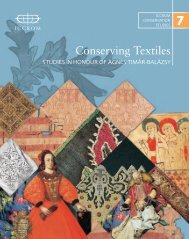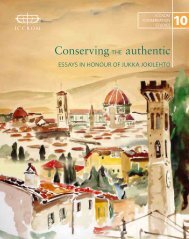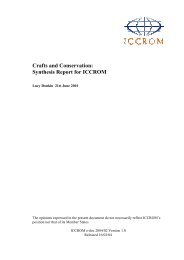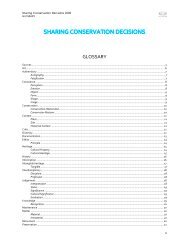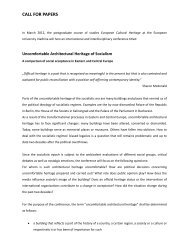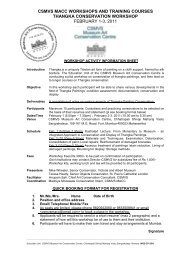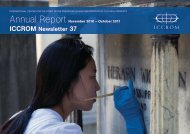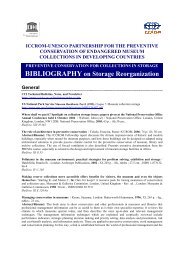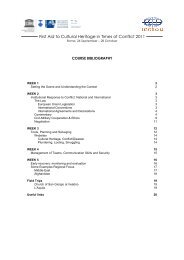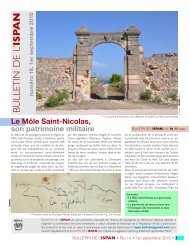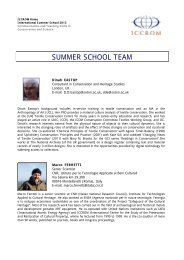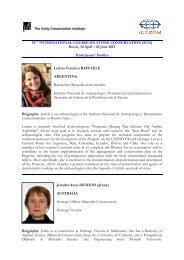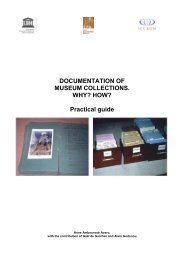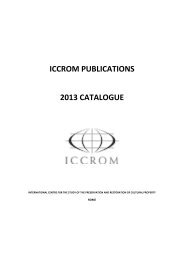part 1 - Iccrom
part 1 - Iccrom
part 1 - Iccrom
You also want an ePaper? Increase the reach of your titles
YUMPU automatically turns print PDFs into web optimized ePapers that Google loves.
MEASURING HERITAGE CONSERVATION PERFORMANCE<br />
6th International Seminar on Urban Conservation<br />
the square outwards. In 1866 the first section of the<br />
Argentine Central Railway (Ferrocarril Central Argentino)<br />
opened, and this determined a new element in<br />
the spatial structuring of the city and the region.<br />
The rise in the number of inhabitants contributed by<br />
immigration, the expansion of the port activity, and<br />
the growing agricultural exports trade helped the<br />
city grow by founding new villages, incorporating<br />
hamlets or adding rural territory. Thus, a city with<br />
varied hues, a mosaic of landscapes with a distinct<br />
identity, was formed.<br />
In the first decade of the 20 th century the works<br />
that would change the city’s appearance were<br />
built: the port, the first urban park (Independence<br />
Park), the hospital, the racecourse and the Saladillo<br />
baths, 2 among others. Rosario became a booming<br />
‘metropolis’, where the modern age has left unique<br />
fingerprints, especially in the downtown area. Until<br />
1930, while there were substitutions of the original<br />
buildings, the city grew on new land. However,<br />
from then on, the city was built on the existing<br />
town. From 1930 to 1966, the country underwent a<br />
social and economic crisis, presided over by military<br />
administrations. The city could not elude the<br />
national reality and experienced scant transformations.<br />
Towards 1968, when the economy and urban<br />
transformations were booming, the Rosario Regulating<br />
Plan was enacted. Its Code stipulated the<br />
division of the urban area into Districts, which arise<br />
from reordering and streamlining the city zones,<br />
and indexes were established to anticipate changes<br />
in the urban landscape.<br />
The city is still growing fast but has to face the<br />
consequences of unattended regulations regarding<br />
urban land ‘qualification’. The lack of appreciation<br />
of the existing city needs to be emphasized. The<br />
indexes suppose an empty lot and no pre-existing<br />
structures are recognized. Therefore, the city heritage<br />
and its urban landscape are left unprotected.<br />
The aforementioned indicates that, for the purposes<br />
Figure 2. Paradigmatic Buildings. Rosario. Central Area<br />
(Source: Arq, Carolina Rainero).<br />
of considering urban heritage, Rosario presents a<br />
complex reality (Figure 2).<br />
2. The city and its urban heritage<br />
Despite having a unique natural coastal landscape<br />
and a wide variety of built heritage, this richness is<br />
not openly recognized by the inhabitants. Some of<br />
the reasons for this are: lack of sensitivity to a common<br />
past, 3 a mercantile nature, and property developers’<br />
speculation, which has pervaded almost all<br />
of the city’s development actions, motivating the<br />
urban heritage devastation for decades, and even<br />
unto the present, due to the current economic boom.<br />
The central area is the most affected area. This presents<br />
paradigmatic works linked to the city’s urban<br />
history where the progress paradigm, understood<br />
as upward development, has caused irreplaceable<br />
losses and generated a change in the landscape<br />
scale. However, if society does not claim protection<br />
of the city heritage, public regulations are left with<br />
little margin to be applied. Unfortunately, in my<br />
view, urban regulations, which have regulated the<br />
city since its inception until the elaboration of the<br />
2007 Urban Plan, did not reconcile appreciation of<br />
the urban land with heritage. The regulating instruments<br />
have always considered the urban land as<br />
empty, with no precursors. This causes vulnerability<br />
in the local urban cultural heritage. 4<br />
3. Heritage regulations<br />
The city’s distribution and construction regulating<br />
instruments have contributed to destruction rather<br />
than protection. As mentioned above, the 1968<br />
Urban Code has been <strong>part</strong>ly responsible for substitutions,<br />
due to the indiscriminate treatment the<br />
urban land has received. However, the first precedent<br />
regarding the intention to conserve and value<br />
the urban heritage dates from 1984, when Decree<br />
No. 0998 was issued and the Evaluating Committee<br />
was formed 5 to evaluate and advise regarding any<br />
intervention on real estate property whose building<br />
permits dated from before 1953. In 1987 the Evaluating<br />
Committee became the Urban and Architectural<br />
Heritage Conservation Committee. By Ordinance<br />
No. 5278, the Urban Conservation Fund of Rosario<br />
was created, which represents 3% of municipal<br />
taxes. Also, demolition permit and approval procedures<br />
were amended. 6 In 1996 the Urban and Architectural<br />
Heritage Conservation and Rehabilitation<br />
Program 7 was established, under the Planning<br />
Office of the Municipality of Rosario.<br />
Rainero, C. 2012. How to register memory? Documentation, recording, archiving and preservation of intangible cultural heritage in<br />
Venezuela. In Zancheti, S. M. & K. Similä, eds. Measuring heritage conservation performance, pp. 59-66. Rome, ICCROM.<br />
60



